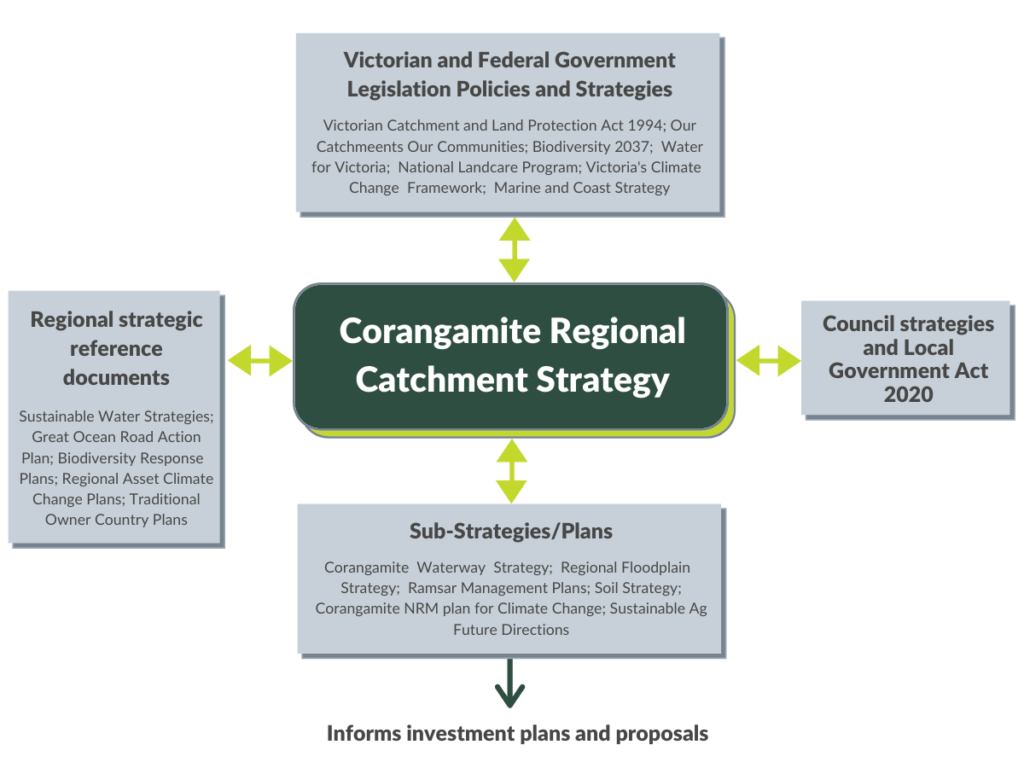Key Legislative and Policy Frameworks
The Regional Catchment Strategy (RCS) has been prepared under the provisions of the Catchment and Land Protection Act, 1994 (CaLP Act), drawing on two key objectives of that Act:
- balancing land productivity and conservation outcomes
- encouraging and supporting community engagement in catchment management.
The RCS has also been developed in accordance with the requirements of national and state legislation and policies relating to biodiversity, land and water resources.
Implementation of this RCS will support regional delivery of national and state natural resource management legislation and policy.

More Information
Regional Vision
Regional Outcomes by Themes
Landscape System Outcomes by Themes
Priority Directions within Landscape Systems
Implementation plan & Monitoring, evaluation and reporting plan – Delivery of RCS outcomes
This includes, but is not limited to the following:
Water for Victoria is a plan for a future with less water as Victoria responds to the impact of climate change and a growing population. The actions set out in the plan support a healthy environment, a prosperous economy with growing agricultural production, and thriving communities.
Victorian Waterway Management Strategy provides the framework for government, in partnership with the community, to maintain or improve the condition of rivers, estuaries and wetlands so that they can continue to provide environmental, social, cultural and economic values for all Victorians.
Our Catchments Our Communities commits to the continuation of the community’s important role in land management and puts it at the centre of how integrated catchment management is planned and delivered in Victoria.
Protecting Victoria’s Environment ‐ Biodiversity 2037 is Victoria’s plan to stop the decline of our native plants and animals and improve our natural environment.
Strong, Innovative, Sustainable: A new strategy for Agriculture in Victoria is a new ten year strategy that supports a stronger, more innovative and sustainable agriculture industry.
Victoria’s Climate Change Strategy sets out the Government’s plan for further reducing our emissions and building resilience to the impacts of climate change. In addition, a Natural Environment Adaptation Action Plan will be released in early 2022 and will iteratively guide adaptation efforts over the next five years and lay vital foundations in a systematic way to facilitate adaptation of the natural environment..
The State Environment Protection Policy (Waters) ensures Victoria has clear and relevant standards, legal rules, and statutory obligations to protect and improve the health of our water environments.
Victoria’s Marine and Coastal Policy guides decision makers in the planning, management and sustainable use of our coastal and marine environment. It provides direction to decision makers including local councils and land managers on a range of issues such as dealing with the impacts of climate change, population growth and ageing coastal structures. The associated Marine and Coastal Strategy is a five-year action plan that implements the Marine and Coastal Policy.
Pupangarli Marnmarnepu ‘Owning Our Future’ Aboriginal Self-Determination Reform Strategy 2020-2025 is DELWP’s roadmap to building a better future with Traditional Owners and Aboriginal Victorians, including ensuring that Traditional Owners’ aspirations for land, water and culture are realised.
The Eastern Maar Country Plan (Meerreengeeye ngakeepoorryeeyt) defines Eastern Maar’s vision for the future and identifies six goals that form the focus of effort. Each of the six goals has a number of objectives that are worked towards by Eastern Maar as individuals, as a nation and in partnership with others.
The Wadawurrung Healthy Country Plan (Paleert Tjaara Dja) articulates how Wadawurrung see Country being cared for and managed over the next 10 years. This includes walking together with government (federal, state, and local) and other key stakeholders to achieve self-determination, ensuring sustainable Wadawurrung managed investment in Country going forward.
Victorians Volunteering for Nature ‐ Environmental Volunteering Plan
The Australian Government’s National Landcare Program is a key part of the Australian Government’s commitment to protect and conserve Australia’s water, soil, plants, animals and ecosystems, as well as supporting the productive and sustainable use of these valuable resources.

Summary of Diagram (Vision Impaired)
- Regional strategic reference documents
- Sustainable Water Strategies; Great Ocean Road Action Plan; Biodiversity Response Plans; Regional Asset Climate Change Plans; Traditional Owner Country Plans
- Victorian and Federal Government Legislation Policies and Strategies
- Victorian Catchment and Land Protection Act 1994; Our Catchmeents Our Communities; Biodiversity 2037; Water for Victoria; National Landcare Program; Victoria’s Climate Change Framework; Marine and Coast Strategy
- Council strategies and Local Government Act 2020
- Sub-Strategies/Plans
- Corangamite Waterway Strategy; Regional Floodplain Strategy; Ramsar Management Plans; Soil Strategy; Corangamite NRM plan for Climate Change; Sustainable Ag Future Directions
- Informs investment plans and proposals
- Corangamite Waterway Strategy; Regional Floodplain Strategy; Ramsar Management Plans; Soil Strategy; Corangamite NRM plan for Climate Change; Sustainable Ag Future Directions
The Regional Catchment Strategy also aligns with and contributes to the United Nations (UN) Sustainable Development Goals. This is especially the case for the five following goals:
| GOAL | Outcome | RCS contribution |
| 6 CLEAN WATER AND SANITATION | Ensure availability and sustainable management of water and sanitation for all. | Clean water is a key outcome of the RCS. |
| 11 SUSTAINABLE CITIES AND COMMUNITIES | Make cities and human settlements inclusive, safe, resilient and sustainable. | With two major centres in the region this is addressed through the Themes and Priority Directions. The Communities theme has a focus on this aspect as well. |
| 13 CLIMATE ACTION | Take urgent action to combat climate change and its impacts. | Adaptation and mitigation are embedded into RCS Themes and Priority Directions |
| 14 LIFE BELOW WATER | Conserve and sustainably use the oceans, seas and marine resources for sustainable development. | Helping to maintain the quality of the world’s oceans through appropriate catchment management |
| 15 LIFE ON LAND | Protect, restore and promote sustainable use of terrestrial ecosystems, sustainably manage forests, combat desertification, and halt and reverse land degradation and halt biodiversity loss. | Embedded in goals for each of the Themes and reflected in Priority Directions |



